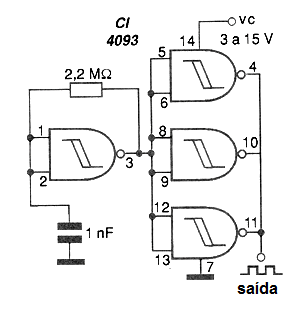CMOS integrated circuits are sensitive to supply voltages in terms of signal propagation time. Thus, we can take advantage of the variation of the signal propagation time in a port, to include it in the feedback circuit and thus, control its frequency. This is done in the circuit shown in the figure where we can have frequency over a wide range of values when we vary the supply voltage between 3 and 15 V. In this range of values, the frequency will typically vary between 450 Hz and 5 kHz when the control voltage (Vc) travels from 3 to 9 V. With 15 V this frequency will be close to 50 kHz. The central value of the generated frequency depends on the capacitor and its minimum value is around 50 pF. The resistor can also be reduced to achieve even higher frequencies. It is important to note that the output signal is rectangular, but as the circuit is powered by the control voltage, its amplitude varies with frequency. The lower frequency signals are less intense. This problem can be solved with the use of an external buffer powered by a fixed voltage.




